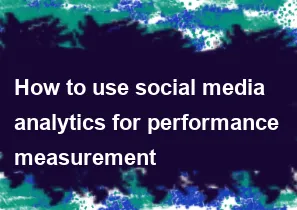How to use social media analytics for performance measurement

Using social media analytics for performance measurement is crucial for understanding the effectiveness of your social media strategy and making informed decisions to optimize your efforts. Here are steps and considerations to help you leverage social media analytics for performance measurement:
Define Key Performance Indicators (KPIs):
- Identify your specific goals and objectives on social media.
- Establish KPIs that align with these goals, such as engagement, reach, conversions, click-through rates, and brand sentiment.
Choose Relevant Metrics:
- Select metrics that directly relate to your KPIs. For example:
- Engagement metrics: likes, comments, shares, retweets.
- Reach metrics: impressions, followers, clicks.
- Conversion metrics: sign-ups, purchases, downloads.
- Select metrics that directly relate to your KPIs. For example:
Utilize Social Media Analytics Tools:
- Use social media analytics tools provided by platforms (e.g., Facebook Insights, Twitter Analytics, Instagram Insights) or third-party tools (e.g., Hootsuite, Buffer, Google Analytics).
- These tools offer in-depth insights into your social media performance, audience demographics, and engagement metrics.
Monitor Engagement and Reach:
- Track the performance of your posts and content to understand what resonates with your audience.
- Analyze reach metrics to evaluate how many people are exposed to your content.
Evaluate Conversion Metrics:
- Measure the effectiveness of your social media campaigns in driving conversions.
- Analyze conversion rates and track the customer journey from social media interaction to the desired action (e.g., making a purchase or signing up for a newsletter).
Assess Audience Insights:
- Understand your audience demographics, interests, and behaviors.
- Use this information to tailor your content and engagement strategies to better connect with your target audience.
Competitor Analysis:
- Compare your social media performance with competitors.
- Identify areas where you excel and areas that may need improvement based on benchmarking against industry standards.
Monitor Trends and Patterns:
- Keep an eye on trends in social media metrics.
- Identify patterns in your data and use this information to adjust your strategy accordingly.
Regularly Review and Adjust Strategy:
- Regularly review your social media analytics reports to spot trends and areas for improvement.
- Use insights to adjust your content strategy, posting schedule, and targeting.
Integrate with Overall Business Goals:
- Connect social media performance metrics with broader business goals.
- Ensure that your social media efforts contribute to the overall success of your organization.
Use A/B Testing:
- Conduct A/B testing to compare different elements of your social media strategy (e.g., headlines, visuals, posting times) and determine what works best.
By consistently monitoring and analyzing social media analytics, you can gain valuable insights to enhance your social media strategy and achieve better performance aligned with your business objectives. Adjustments based on these insights will help you stay competitive and relevant in the dynamic social media landscape.
-
Popular Post
- How to optimize for Google's About This Result feature for local businesses
- How to implement multi-language support in an Express.js application
- How to handle and optimize for changes in mobile search behavior
- How to handle CORS in a Node.js application
- How to use Vue.js with a UI framework (e.g., Vuetify, Element UI)
- How to configure Laravel Telescope for monitoring and profiling API requests
- How to create a command-line tool using the Commander.js library in Node.js
- How to implement code splitting in a React.js application
- How to use the AWS SDK for Node.js to interact with various AWS services
- How to use the Node.js Stream API for efficient data processing
- How to implement a cookie parser middleware in Node.js
- How to implement WebSockets for real-time communication in React
-
Latest Post
- How to implement a dynamic form with dynamic field styling based on user input in Next.js
- How to create a custom hook for handling user interactions with the browser's device motion in Next.js
- How to create a custom hook for handling user interactions with the browser's battery status in Next.js
- How to implement a dynamic form with dynamic field visibility based on user input in Next.js
- How to implement a dynamic form with real-time collaboration features in Next.js
- How to create a custom hook for handling user interactions with the browser's media devices in Next.js
- How to use the useSWRInfinite hook for paginating data with a custom loading indicator in Next.js
- How to create a custom hook for handling user interactions with the browser's network status in Next.js
- How to create a custom hook for handling user interactions with the browser's location in Next.js
- How to implement a dynamic form with multi-language support in Next.js
- How to create a custom hook for handling user interactions with the browser's ambient light sensor in Next.js
- How to use the useHover hook for creating interactive image zoom effects in Next.js